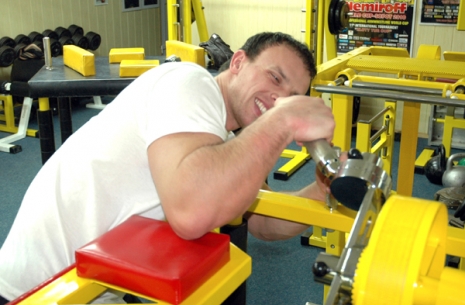
How to armwrestle without getting pains in your wrist and fingers? ()
Armwrestling is a sport with a high risk of top extremities injury. And even though proper warmup and training can minimize the risk of elbow injury, still the “tennis elbow” prevails in the sport.
“Tennis elbow” (enthesopathy of shoulder and elbow region) is synonymous with many ailments that result in acute pain when bending elbow, wrist and fingers. It also results in weakening of arm and wrist.
Mechanics:
As a result of repetitive bending and rotation, the muscle tension can cause injury, inflammation and other pathological changes in muscular-tendon-bone connections. The pain locates itself in a small bone structure (epicondylus lateralis) on the outside of the elbow, where all the wrist and finger muscles have their fastenings. The surface of this spot is so small compared to the tensions applied to it, that it’s very prone to injury. In short, due to its complicated anatomy, the elbow joint is one of the joints most prone to professional and sports injuries. It’s also very hard to heal completely and can return.
Why is that?
The elbow joint, just like any other joint, is encased in a joint capsule. Around the joint, in many spots, there are muscle tendons. This particular joint has a very thin layer of muscle and fat (hence its high injury rate). Tendons can only take so much strain, after all. Beyond that lies injury.
Train regularly to increase stamina.
The muscle and tendon stamina can be increased by regular, professional training. The “tennis elbow” affects mostly those who don’t train regularly. It’s a common mistake to try to “exercise” already injured tendons – this only leads to further injury. The joints needs to heal completely. This is done by minimizing the pull on the hurt tissue.
Symptoms:
pain in the exterior part of the elbow (often radiating up and down the arm)
palpative sensitivity in the epicondylus lateralis region
weakening of the wrist, trouble with simple movements, like raising a cup, etc.
loss of muscular strength
acute pain when bending the wrist upwards, rotating arm outwards, straightening fingers.
Therapy:
Preservative therapy:
Relative ease of pain can be attained by placing the limb in an arm splint (bent at 90 º angle), usually for about 14 days. Physiotherapy is recommended (iontophoresis, ultrasound, criotherapy), massages, hot and cold compresses; orthesis to ease the strain. Of course, rest from training and any kind of strain is strongly advised. In some cases painkillers, anti-inflammatory medicine, or steroid therapy is prescribed.
Surgery.
Used in hard cases, recommended when preservative therapy doesn’t work, needed when muscle fastening needs to be relieved.
Without proper diagnosis of causes, therapy of “tennis elbow” can only be symptomatic, and can be prolonged and ineffective. Usually rest and medication is enough. If not successful, however, rehabilitation is necessary.What to expect from physical therapy?
The speeding up of the process of regeneration. Hot temperature has such an effect, Sollux lamp is recommended. However, the most full effect can be attained with laser. A sufficient dose of ultraviolet radiation speeds up recovery. Laser therapy should be supplemented by magnetotherapy, because the magnetic field penetrates far deeper into the joint, thus stimulating the regeneration of tissue that cannot be reached with laser (which doesn’t penetrate bone). Great effects have been observed with shock wave therapy. Acoustic waves transfer energy to the injured places. This is a modern, painless way of fighting acute pain in the bone – muscle structure. It’s recommended in therapy of ligaments, fastenings and inflammations. It’s widely used around the world in sports therapy, orthopedics and rehabilitation.
Prevention
Remember to practice armwrestling (and any other sports) with intensity suited to your body. Strengthen your forearm muscles by regular training with increasing weight. Don’t forget to take breaks mid-training, and monotypic workout. And always warm up before any exercise, and especially before tournaments.
Certified physiotherapist Monika Sielicka



Archive >>>
Champions’ Training. Taras Ivakin, part two
Armwrestling training - warmup
How famous armwrestlers celebrated New Year?
Last week's most popular articles